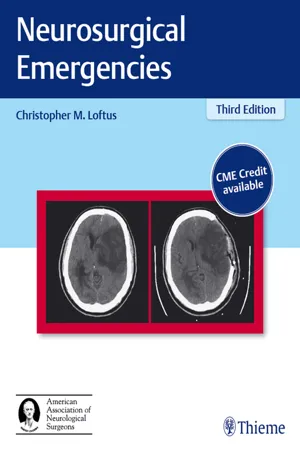
- 420 pages
- English
- PDF
- Available on iOS & Android
Neurosurgical Emergencies
About this book
A state-of-the-art reference on the management and treatment of neurosurgical emergencies
The third edition of this acclaimed book covers frequently encountered neurosurgical emergencies, with contributions from renowned experts in their respective subspecialties. Clinical insights and easy-to-follow protocols are presented for emergencies associated with disease, infection, and trauma - and complications such as status epilepticus and acute shunt malfunction. Injury classification, evaluation, clinical presentation, imaging, surgical indications, approaches, and prognosis are presented for each condition. Concise, evidence-based descriptions enable readers to rapidly gain a solid understanding of the pathogenesis of each problem.
The authors retained the scope and content of previous editions and added six new chapters that reflect recent advances. These include novel invasive brain monitoring techniques and their relevance to clinical practice, emergency surgery for stroke, emergency endovascular stroke treatment, cerebral venous thrombosis, consideration of cervical stenosis as an emergency, and emergent presentation and management of spinal dural arteriovenous fistulas and vascular lesions.
Key Features
- Updated from black and white to full-color illustrations
- Current guidelines for managing a full spectrum of intracranial, spinal, and peripheral nerve emergencies - from assessment of acute loss of consciousness - to pituitary apoplexy, cerebral herniation, and penetrating spine and peripheral nerve injuries
- Neurosurgical emergencies in pediatric patients including spinal cord injury and perinatal management of myelomeningocele
- Treatment and management of spontaneous intracerebral, subarachnoid, and intraspinal hemorrhages
- Recognition and management of intrathecal baclofen and narcotic withdrawal
This stellar resource is a must-have for practicing neurosurgeons and emergency medicine specialists. It will also greatly benefit residents and fellows in these fields of medicine.
Frequently asked questions
- Essential is ideal for learners and professionals who enjoy exploring a wide range of subjects. Access the Essential Library with 800,000+ trusted titles and best-sellers across business, personal growth, and the humanities. Includes unlimited reading time and Standard Read Aloud voice.
- Complete: Perfect for advanced learners and researchers needing full, unrestricted access. Unlock 1.4M+ books across hundreds of subjects, including academic and specialized titles. The Complete Plan also includes advanced features like Premium Read Aloud and Research Assistant.
Please note we cannot support devices running on iOS 13 and Android 7 or earlier. Learn more about using the app.
Information
Table of contents
- Neurosurgical Emergencies
- Title Page
- Copyright Page
- Dedication
- Contents
- Continuing Medical Education Credit Information and Objectives
- Disclosure Information
- Foreword
- Preface
- Contributors
- 1 Assessment of Acute Loss of Consciousness
- 2 Intracranial Pressure Monitoring and Management of Raised Intracranial Pressure
- 3 Invasive Multimodality Brain Monitoring
- 4 Management of Acute Hydrocephalus
- 5 The Recognition and Management of Cerebral Herniation Syndromes
- 6 Penetrating Cerebral Trauma
- 7 Extra-Axial Hematomas
- 8 Spontaneous Intracerebral Hemorrhage
- 9 Pituitary Apoplexy
- 10 Acute Management of Subarachnoid Hemorrhage
- 11 Chemical Thrombolysis and Mechanical Thrombectomy for Acute Ischemic Stroke
- 12 Surgical Interventions for Acute Ischemic Stroke
- 13 Cerebral Venous Thrombosis
- 14 Cerebral Infectious Processes
- 15 Emergency Treatment of Brain Tumors
- 16 Acute Bony Decompression of The Optic and Facial Nerves
- 17 Status Epilepticus
- 18 The Evaluation and Management of Combined Cranial, Spinal, and Multisystem Trauma
- 19 Summary and Synopsis of The Brain Trauma Foundation Head Injury Guidelines
- 20 Special Considerations of Antiplatelet Therapy, Anticoagulation, and The Need For Reversal In Neurosurgical Emergencies
- 21 Acute Intervention for Cervical, Thoracic, and Lumbar Spinal Disk Disease
- 22 Is Cervical Stenosis An Emergency?
- 23 The Intensive Care Management of Spine– and Spinal Cord–Injured Patients
- 24 Biomechanical Considerations for Operative Interventions in Vertebral Column Fractures and Dislocations
- 25 Athletic Injuries and Their Differential Diagnosis
- 26 Penetrating Spine Trauma
- 27 Spinal Cord Compression Secondary to Neoplastic Disease: Epidural Metastasis and Pathologic Fracture
- 28 Intraspinal Hemorrhage
- 29 Emergent Presentation and Management of Spinal Dural Arteriovenous Fistulas and Vascular Lesions
- 30 Spinal Infections
- 31 Summary of Spine Injury Treatment Guidelines
- 32 Penetrating Injuries of Peripheral Nerves
- 33 Acute Management of Compressive Peripheral Neuropathies
- 34 Spinal Cord Injury and Spinal Cord Injury Without Radiographic Abnormality in Children
- 35 Acute Shunt Malfunction
- 36 The Perinatal Management of a Child Born with a Myelomeningocele
- 37 Recognition and Management of Intrathecal Baclofen and Narcotic Withdrawal Syndromes
- Index